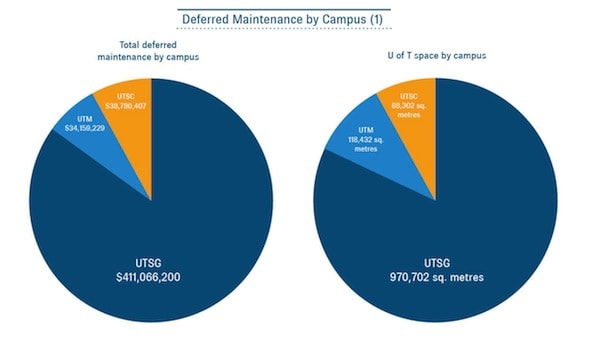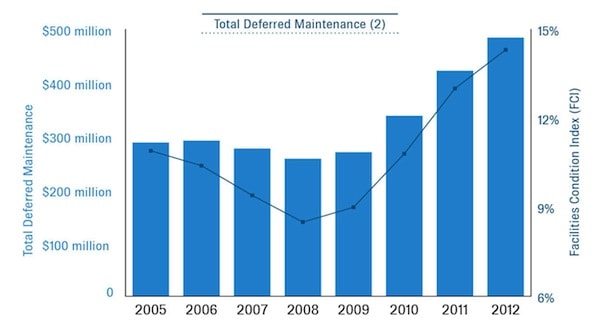Brad Evoy stepped out of the office to get lunch on August 1, 2012. When he got back, he found that part of the ceiling in the main lobby of the Graduate Students’ Union (GSU) building on Bancroft Avenue had fallen in.
“We weren’t expecting it — no one had noticed there was an issue with the ceiling at the time, from our side or the university’s,” explained Evoy, the internal commissioner for the GSU.
There are over a hundred buildings on U of T’s three campuses, and many are in need of significant maintenance and renovation work. The 2012 Deferred Maintenance report estimated the university’s total deferred maintenance liability at $484 million. The report also estimated that U of T must spend $19 million a year to maintain the current conditions of its buildings. Last year, the Ontario government provided $3.2 million through its Facilities Renewal Program (FRP).
Deferring maintenance is simply not a good idea, said Tamer El-Diraby, an associate professor in U of T’s Department of Civil Engineering. “This is maintenance that is needed. If you do it early, that means it’s going to be a small job. If you do it late, it’s going to be a bigger job and it will cost more.”
Evoy said the university’s Facilities & Services responded to the problem swiftly. “They jumped on it quite quickly; they checked it for asbestos, sealed off the area, and dealt with it.”
Deferred maintenance involves postponing maintenance activities because of a shortage of funds, and several organizations in the post-secondary education sector believe that funding pressures on universities are causing that gap to grow. “There’s been an endless cat-and-mouse game about deferred maintenance; the cat-and-mouse game is universities and colleges trying to get across to the government that if we don’t pay to keep these buildings up, it costs more for the taxpayers and the students and families in the long run,” said U of T president David Naylor in a recent interview with The Varsity.
Brad Duguid, minister of training, colleges, and universities, said that the province has funded universities at record levels since the Liberals took power in 2003. “Nobody can suggest for a second that this government hasn’t been there for the post-secondary education system when it comes to capital funding. I think we’ve got very significant results out of the investments that we’re making in post-secondary education.”
Why defer maintenance?
Ron Swail, U of T’s assistant vice-president of facilities services, said that there are a number of factors that determine whether a maintenance job is performed immediately or put off until later. “Immediate repairs would routinely be conducted if there is a risk to occupant or staff members’ health and safety,” said Swail, citing building accessibility and usability for teaching as other important factors.
U of T’s total assessed deferred maintenance and score on the Facilities Condition Index, a measure of building condition, have both increased significantly over the last few years — from a recent low of $257 million and 8.5 per cent respectively in 2007 to 14.3 per cent in 2012 (see graph 2 above). Deferred maintenance calculations do not include the federated colleges — Victoria, Trinity and St. Michael’s Colleges — which conduct their own maintenance.
Graeme Stewart, communications manager at the Ontario Confederation of University Associations (OCUFA), said that underfunding is affecting the quality of education and research at Ontario universities. “I think the bottom line is as these buildings age, and as they are not renewed, essentially everything that goes on in those buildings comes under threat.”
OCUFA’s 2012 Ontario Budget Brief called on the provincial government to raise direct maintenance funding to Ontario universities via the FRP from the current level of $17 million a year to an annual $200 million by 2015–2016. It also cited estimates from the Council of Ontario Universities (COU) that suggest that maintaining facilities in their current condition would require $380 million in funding per year over the next decade.
Duguid said those demands are unrealistic. “I think it’s a little fanciful to suggest that somehow the province can just wave a magic wand and come up with hundreds of billions of more dollars every year.”
Is there a funding problem?
Michael Kennedy, a media officer for U of T, said that the university acknowledges the funding pressures on the government. However, “the low level of funding for maintenance is an ongoing issue for the University and one that is regularly raised with the provincial government.”
Naylor said that what matters is not necessarily the dollar value of deferred maintenance, but “do we have a lot of deferred maintenance that is reasonably pressing, and what are prudent and sensible responses to get it fixed to avoid a crisis that affects student, faculty, and staff, or avoids needless expenditure? The answer is, we have a lot, we know how big the level is, but for many years it has been almost impossible to get the province to engage in a serious discussion about putting in play the funds to fix those problems.”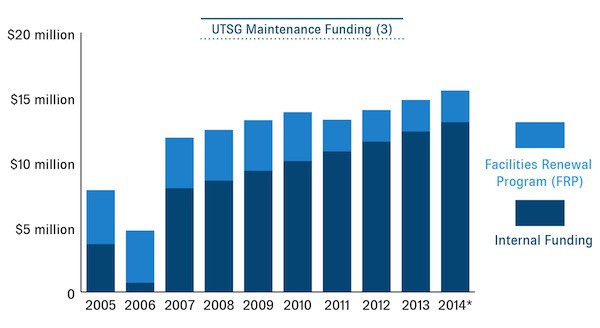
The university’s deferred maintenance reports suggest FRP funding has fallen, from a high of $4.7 million in 2010 (see graph 3 above). Jelena Damjanovic, a media relations assistant at the university, indicated that FRP funding fell because “the entire program was reduced by the province. That is why the dollar share allocated to the University of Toronto fell.”
Duguid said that’s not necessarily the case. “The funding levels haven’t changed. Different institutions will get different amounts every year, based on their project submissions. So that’s a number that will fluctuate a little over time, but the Facilities Renewal Program, it fluctuates just based on projects that are submitted.”
The COU is an umbrella organization that links Ontario’s publicly funded universities and advocates on their behalf. COU president Bonnie Patterson is registered to lobby the provincial government on several subjects, including infrastructure, and the organization also retains Toronto firm Counsel Public Affairs Inc. The COU declined to make anyone available to comment for this story. Bob Lopinski, a principal at Counsel and a former senior official in the McGuinty government, said the firm does not discuss client matters publicly.
Duguid maintained that the government has shown its commitment to funding the province’s universities. “In all, since 2003, we’ve invested $3.1 billion in capital funding, and one-third of that, a billion dollars, was specifically targeted to renewal, repair, and modernization across the sector. U of T got a good share of the funding for much of that capital funding,” he said.
Can it be fixed?
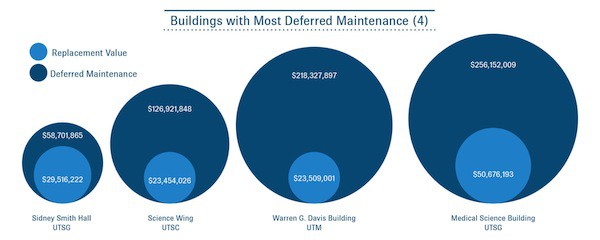
The province has announced $800 million in capital funding for the next three years, though the ministry could not provide an estimate of how much of that money would be put towards new projects, and how much to maintenance spending.
Duguid said there are currently no plans for more capital spending once that money runs out. “In the near future, as we’re working to balance our books in the province over the next number of years, there is no plan at this point for additional new capital dollars,” he said. However, he emphasized that the province has already made significant improvements in funding for Ontario’s post-secondary universities.
U of T’s administration stressed that while funding pressures are a problem, the situation is under control. “While we are advocating for more funding, we are managing the situation,” said Damjanovic.
Swail acknowledged that this year’s report is likely to see a further rise in total deferred maintenance, although he emphasized that the university has made significant progress in tackling the most urgent projects. According to Swail, the total amount of “priority one” deferred maintenance items have decreased steadily for the past seven years, from approximately $76 million to just over $18 million (see graph 5 below).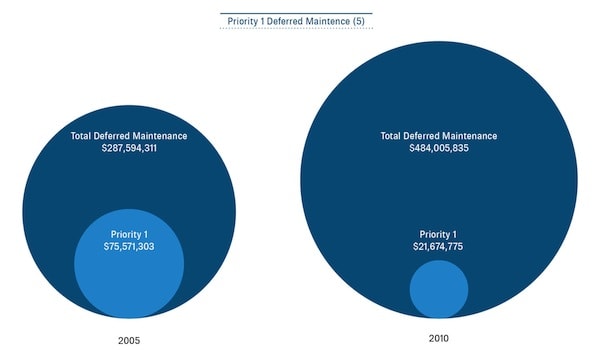
With new construction projects underway on all three campuses, Evoy said the university needs to concentrate on fixing its existing structures. “It’s extremely worrying; I think that as a university we should be trying to not just build outwards and seem impressive, but maintain the structures and capacities that we have,” he said.
The next deferred maintenance report will be discussed at the Business Board meeting on January 27, 2014.


